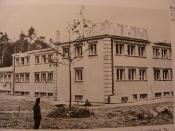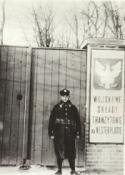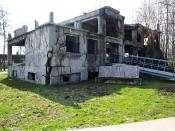Polska Wojskowa Składnica Tranzytowa na Westerplatte - OP681B
Symbol of World War II
Właściciel:
telefonalarmowy
 Zaloguj się, by zobaczyć współrzędne.
Zaloguj się, by zobaczyć współrzędne.
 363x znaleziona
363x znaleziona  25x nieznaleziona
25x nieznaleziona  6 komentarze
6 komentarze  12 obserwatorów
12 obserwatorów  Oceniona jako: znakomita
Oceniona jako: znakomita
 9 x rekomendowana
9 x rekomendowana
Skrzynka rekomendowana przez:
Agatha, Aki., AldonaH, Człowiekwrzątek, Harry_Hole, soolash, unieski, wasam82, YazJazz
Musisz się zalogować,
aby zobaczyć współrzędne oraz
mapę lokalizacji skrzynki
aby zobaczyć współrzędne oraz
mapę lokalizacji skrzynki
 Atrybuty skrzynki
Atrybuty skrzynki





About the site:
Decision of the Council of the League of Nations in 1924, since 1926 the Westerplatte peninsula was handed Poland to the base of transhipment of arms and ammunition. By 1939 he performed the service on Westerplatte 88 soldiers. In the summer of 1939 to increase tension in the German-Polish crew base has been strengthened to about 210 soldiers and reservists from civilian employees. Commander of the repository in 1938 was Major Henryk Sucharski, and the commander of the guard crew Captain Francis Dabrowski.
September 1, 1939 in the chair. 4.45 salvo of 280-millimeter guns arrived in Gdansk with an allegedly peaceful visit of the German battleship Schleswig-Holstein launched an assault on the Polish infantry outpost on Westerplatte. For seven days the crew resisted numerous attacks from the base of the peninsula, bombed from the air and shelled by German artillery guns and mortars. September 7 against the overwhelming superiority of the enemy and exhausted crew of Major Henryk Sucharski decided to surrender. During the fighting killed at least fifteen Polish soldiers, many were injured. German losses are still unknown.
After the surrender of Polish troops were sent to German POW camps, where they stayed until 1945.
The building of "new" barracks was built between 1934-1935 by replacing the "old" barracks as a resident crew. The building, as the then standards, featuring a very contemporary feel. It had heating, large bathrooms, furniture and cabinets for the soldiers, infirmary and radio.
The present appearance of the building is the result of war damage (mainly those from 1945) and the post-war devastation. North wing was demolished in the 60's, during the construction of the mound, the monument and the promenade.
---------------------------------------------------------------------------------------------------------
About cache:
Cache hidden in a dilapidated building "new" military barracks in the main room on the lower level.
Be careful, because the place is crowded with tourists for most of the day in the year!
Decision of the Council of the League of Nations in 1924, since 1926 the Westerplatte peninsula was handed Poland to the base of transhipment of arms and ammunition. By 1939 he performed the service on Westerplatte 88 soldiers. In the summer of 1939 to increase tension in the German-Polish crew base has been strengthened to about 210 soldiers and reservists from civilian employees. Commander of the repository in 1938 was Major Henryk Sucharski, and the commander of the guard crew Captain Francis Dabrowski.
September 1, 1939 in the chair. 4.45 salvo of 280-millimeter guns arrived in Gdansk with an allegedly peaceful visit of the German battleship Schleswig-Holstein launched an assault on the Polish infantry outpost on Westerplatte. For seven days the crew resisted numerous attacks from the base of the peninsula, bombed from the air and shelled by German artillery guns and mortars. September 7 against the overwhelming superiority of the enemy and exhausted crew of Major Henryk Sucharski decided to surrender. During the fighting killed at least fifteen Polish soldiers, many were injured. German losses are still unknown.
After the surrender of Polish troops were sent to German POW camps, where they stayed until 1945.
The building of "new" barracks was built between 1934-1935 by replacing the "old" barracks as a resident crew. The building, as the then standards, featuring a very contemporary feel. It had heating, large bathrooms, furniture and cabinets for the soldiers, infirmary and radio.
The present appearance of the building is the result of war damage (mainly those from 1945) and the post-war devastation. North wing was demolished in the 60's, during the construction of the mound, the monument and the promenade.
---------------------------------------------------------------------------------------------------------
About cache:
Cache hidden in a dilapidated building "new" military barracks in the main room on the lower level.
Be careful, because the place is crowded with tourists for most of the day in the year!
 Dodatkowe informacje
Dodatkowe informacje
Musisz być zalogowany, aby zobaczyć dodatkowe informacje.
 Obrazki/zdjęcia
Obrazki/zdjęcia
 Wpisy do logu:
Wpisy do logu:
 363x
363x
 25x
25x
 6x
6x




 Opis
Opis





